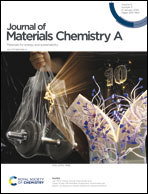Ce ions and polyaniline co-intercalation into MOF-derived porous V2O5 nanosheets with a synergistic energy storage mechanism for high-capacity and super-stable aqueous zinc-ion batteries†
Abstract
Layered vanadium oxides with highly open crystal structures and high theoretical capacity are regarded as the most promising cathode materials for high-performance aqueous zinc-ion batteries (ZIBs). However, the low specific surface area and almost nonporous features of commercial V2O5 inevitably lead to limited active sites and sluggish ion transport rate, and also the inherent poor conductivity and narrow interlayer spacing of V2O5 significantly affect the electrode kinetics and hinder its practical application. Herein, to address these issues, a novel “three-in-one” strategy was proposed by co-intercalating Ce ions and polyaniline (PANI) into V-MOF-derived porous V2O5 (denoted as CPVO) through a simple one-step hydrothermal method. The high specific surface area and nanosheet-like porous structure endowed CPVO with more Zn2+ diffusion channels and electrochemical active sites, leading to a fast Zn2+ migration rate and high specific capacity (498.5 mA h g−1 at 0.1 A g−1 and 98.9% capacity retention after 100 cycles). Furthermore, the co-intercalated Ce ions and PANI acting as pillars led to the synergistic energy storage mechanism of “interlayer engineering” and “structural deformation confinement”, which enormously expanded the interlayer spacing and weakened the electrostatic interaction between Zn2+ and the host material, ultimately resulting in superior rate capability (385.6 mA h g−1 at 5.0 A g−1) and remarkable cycling stability (93.8% capacity retention after 2000 cycles at 10.0 A g−1). Kinetics analysis and DFT calculations further verified the enhanced Zn2+ storage performance. The proposed co-intercalation strategy of rare earth ions and conductive polymers with a synergistic effect opens up a new avenue for the development of advanced cathode materials for aqueous ZIBs.



 Please wait while we load your content...
Please wait while we load your content...